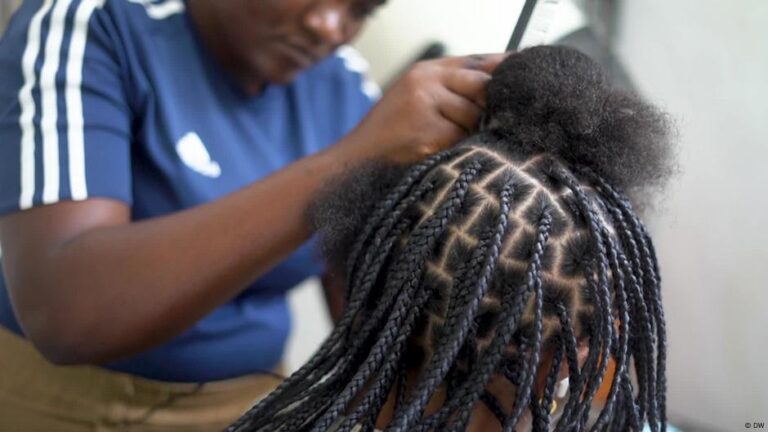Synthetic hair products are in the spotlight after a study found some materials sold to US consumers contain cancer-causing chemicals.
For African women, braiding has for decades helped them maintain their natural hair — keeping it protected from breakage and damage. Many women use “synthetic hair” to make braiding easier.
The materials most used for synthetic braids are Kanekalon and Toyokalon, which were developed by Japanese chemical manufacturers in the fifties.
Unlike real hair, synthetic weaves retain their shape longer and require little maintenance, making them a convenient option for those who want to keep a particular hairstyle for a long time.
But in places like the US, investigations have found some products could be dangerous. Last year, US-based consumer advocacy group Consumer Reports detected dangerous chemicals in synthetic hair.
It has left some women questioning what is in these products and how to protect themselves from harm.
Dangerous chemicals found in synthetic hair brands in the US
For Consumer Reports’ director and head of product safety testing James Rogers, the motivation to assess synthetic hair was personal.
“My two daughters frequently wear braids, and I’ve often been involved in purchasing the hair and helping with takedowns,” Rogers told DW.
Rogers’ team tested two samples from each of the 10 most popular products on the market, all in shades of black or dark brown.
The tests revealed dangerous chemicals in every sample, including benzene — a known carcinogen that raises risk of developing acute myeloid leukemia.
“We talked to the mothers that use these products, and we asked them, ‘What do you use for yourself and your children?’ And that’s how we ended up testing the brands for heavy metals such as lead, cadmium and arsenic,” said Rogers.
There are three exposure pathways for product chemicals to get into the body — inhalation, skin contact and ingestion — and since synthetic hair products are frequently handled, both braiders and their clients could accidentally expose themselves to these dangerous chemicals.
Braiding hair can be brittle, break and be consumed with food as well.
“People may touch their hair and then pick up food to eat with their hands,” Rogers said.
Black women question synthetic hair safety
Chrystal Thomas, a student at the Albert Einstein College of Medicine, US, is a Black woman who had her hair styled with a popular synthetic hair brand at a New York salon. She was using the popular Kanekalon hair brand.
But the experiences she had after were disturbing.
“I couldn’t sleep well, my throat felt irritated, and I had trouble focusing on any type of work I was doing because of the smell. The smell wouldn’t go away even after washing my hair multiple times,” Thomas told DW.
Feeling persistent discomfort, she immediately removed her braids and began researching potential health risks associated with braiding hair for her public health coursework.
“I spent time working on this project and after learning what ingredients are in braids, I decided I don’t want to keep it as course work, I want a conversation about this now,” Thomas said.
Her work inspired the Consumer Reports study.
Black women are the main users of synthetic hair and people of African descent are the largest consumers of hair wigs and extensions. Black women in Washington said the report has them rethinking their use of synthetic hair.
“I feel like I need to embrace my natural hair more so that I could just stray away from all of this chemical stuff,” one told DW.
“We are a group that’s been overlooked in many ways because we are not valued in the same way in some spaces. I’m wearing synthetic hair and it’s easier for me to maintain it this way, so I don’t know if I’m going to transition to natural hairstyles only,” said another.
Are plant-based synthetic hair an alternative?
In 2019, Black entrepreneur Osahon Ojeaga founded Aja Labs, a company researching alternative hair solutions.
After two years of product development, she launched a new line of plant-based hair extensions.
Her inspiration came from the natural resemblance between hair and plant fibers she noticed around her home in North Carolina.
Collaborating with teams at North Carolina State University, she helped develop the first prototype fibers made from plants.
“I’ve dealt with a lifetime of scalp irritation, so I thought, why not reinvent the entire experience?” Ojeaga said.
“Our material for the very first step in the process is a plant. It could be sugarcane, cassava, sugar, beetroot or even corn.”
Although plant-based products are not as long-lasting as synthetics, Ojeaga argues they are healthier.
But with synthetic hair still widespread and providing a more durable product, James Rogers advised consumers to check manufacturers’ websites for any additional information before purchasing products and to read product labels carefully for important details about ingredients.
“If there’s a particular brand that you use or color that you use or texture that you use and you consistently have a negative reaction to it, maybe you should not use that brand and try a different one,” Rogers said.
He also said users should report any concerns or reactions to their healthcare provider.
Edited by: Matthew Ward Agius
Sources
Carcinogenic materials in synthetic braids: an unrecognized risk of hair products for Black women


